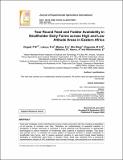| dc.description.abstract | Feed-year strategies involve matching the cycles of dairy production with the changing availabilities of all sources of nutrients over time. Therefore, an understanding of seasonal variation in availability of forage resources is important in future planning and development of appropriate technologies to assure resilience of smallholder dairy systems to seasonal changes. This study was carried out to: 1) evaluate the current pattern of seasonal variation in forage availability in smallholder dairy farms, and 2) assess seasonal variation in year-round forage based feeding strategies in smallholder dairy farms in Eastern Africa. Data was collected from a purposive representative sample of 400 smallholder dairy farmers through cross-sectional and observational studies. The Feed Assessment Tool (FEAST) was used to capture the season’s effect (wet and dry) across high and low altitude areas in Kenya and Tanzania from 2016-2018. Data were analyzed using the generalized linear model (GLMM) procedure of SPSS 21.0 (Chicago, IL, USA), using models that included the fixed effects and random effects; and FEAST Version 2.21. Results showed that location (country), agro-ecological zone and season had a significant influence (p ≤ 0.05) on year-round rainfall variability. Availability and utilization of concentrate feeds, green and dry crop residues, improved fodder, pasture and legume forage throughout the year, were significantly influenced (p ≤ 0.05) by location, agro-ecological zone, seasons and production systems. Correlation between the forage resources revealed highly significant (p ≤ 0.001) and positive relationships in availability and usage across the two countries. From this study, rainfall variability was crucial in determining sources and year-round variation in availability and utilization of forages. Therefore, different seasonality driven site, region or country specific year-round feeding interventions and strategies could be applied depending upon type, source, quantity (availability) and quality of feeds to overcome seasonal milk fluctuations in smallholder dairy farms in Eastern Africa. | en_US |

